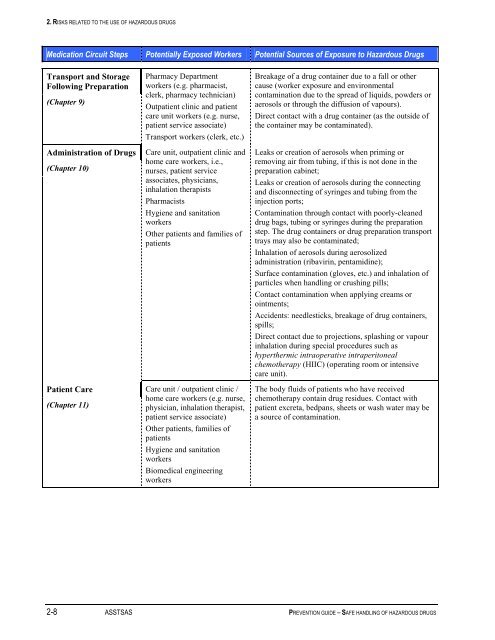Prevention Guide - Safe Handling of Hazardous Drugs - Irsst
Prevention Guide - Safe Handling of Hazardous Drugs - Irsst
Prevention Guide - Safe Handling of Hazardous Drugs - Irsst
You also want an ePaper? Increase the reach of your titles
YUMPU automatically turns print PDFs into web optimized ePapers that Google loves.
2. RISKS RELATED TO THE USE OF HAZARDOUS DRUGS<br />
Medication Circuit Steps Potentially Exposed Workers Potential Sources <strong>of</strong> Exposure to <strong>Hazardous</strong> <strong>Drugs</strong><br />
Transport and Storage<br />
Following Preparation<br />
(Chapter 9)<br />
Administration <strong>of</strong> <strong>Drugs</strong><br />
(Chapter 10)<br />
Pharmacy Department<br />
workers (e.g. pharmacist,<br />
clerk, pharmacy technician)<br />
Outpatient clinic and patient<br />
care unit workers (e.g. nurse,<br />
patient service associate)<br />
Transport workers (clerk, etc.)<br />
Care unit, outpatient clinic and<br />
home care workers, i.e.,<br />
nurses, patient service<br />
associates, physicians,<br />
inhalation therapists<br />
Pharmacists<br />
Hygiene and sanitation<br />
workers<br />
Other patients and families <strong>of</strong><br />
patients<br />
Patient Care Care unit / outpatient clinic /<br />
home care workers (e.g. nurse,<br />
(Chapter 11)<br />
physician, inhalation therapist,<br />
patient service associate)<br />
Other patients, families <strong>of</strong><br />
patients<br />
Hygiene and sanitation<br />
workers<br />
Biomedical engineering<br />
workers<br />
Breakage <strong>of</strong> a drug container due to a fall or other<br />
cause (worker exposure and environmental<br />
contamination due to the spread <strong>of</strong> liquids, powders or<br />
aerosols or through the diffusion <strong>of</strong> vapours).<br />
Direct contact with a drug container (as the outside <strong>of</strong><br />
the container may be contaminated).<br />
Leaks or creation <strong>of</strong> aerosols when priming or<br />
removing air from tubing, if this is not done in the<br />
preparation cabinet;<br />
Leaks or creation <strong>of</strong> aerosols during the connecting<br />
and disconnecting <strong>of</strong> syringes and tubing from the<br />
injection ports;<br />
Contamination through contact with poorly-cleaned<br />
drug bags, tubing or syringes during the preparation<br />
step. The drug containers or drug preparation transport<br />
trays may also be contaminated;<br />
Inhalation <strong>of</strong> aerosols during aerosolized<br />
administration (ribavirin, pentamidine);<br />
Surface contamination (gloves, etc.) and inhalation <strong>of</strong><br />
particles when handling or crushing pills;<br />
Contact contamination when applying creams or<br />
ointments;<br />
Accidents: needlesticks, breakage <strong>of</strong> drug containers,<br />
spills;<br />
Direct contact due to projections, splashing or vapour<br />
inhalation during special procedures such as<br />
hyperthermic intraoperative intraperitoneal<br />
chemotherapy (HIIC) (operating room or intensive<br />
care unit).<br />
The body fluids <strong>of</strong> patients who have received<br />
chemotherapy contain drug residues. Contact with<br />
patient excreta, bedpans, sheets or wash water may be<br />
a source <strong>of</strong> contamination.<br />
2-8 ASSTSAS PREVENTION GUIDE – SAFE HANDLING OF HAZARDOUS DRUGS

















